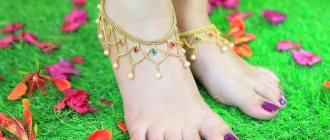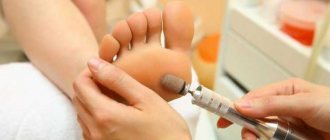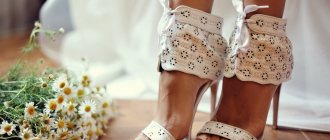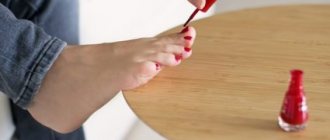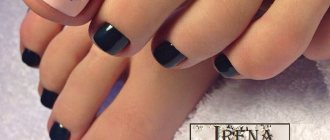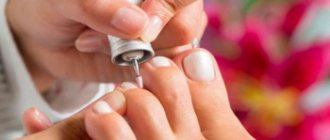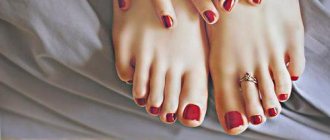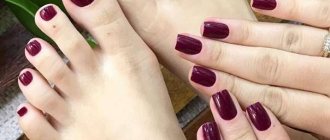One of the most common and popular techniques for treating toenails and feet is the classic pedicure. The technique is the ancestor of all modern techniques, since its elements appeared a long time ago, 5000 years ago. For example, steaming and trimming cuticles. In those days, gold instruments were used, and high-quality pedicures were the prerogative of the highest nobility. Well-groomed feet and toes are not just aesthetically pleasing. A trimmed pedicure improves mood, allows women to gain confidence in themselves and enjoy pleasant, restorative procedures.
View this post on Instagram
Posted by Unreel (@extremeofficial)
Classic pedicure
Classic (edged) pedicure is the first type of pedicure that was invented for foot care. To carry it out, the skin is first steamed in warm water with the addition of sea salt or keratolytic gel. Until now, softened keratinization was removed with pumice and blades, but now the blades can be supplemented with cutters, that is, an element of hardware pedicure.
The classic technique remains only for home use; salons and beauty centers do not use trimmed pedicures due to many disadvantages.
Advantages: it can be carried out at home if you have the appropriate experience.
Disadvantages of classic pedicure:
- Damage to the dermis in the treatment area.
- Risk of infection.
- Rapid formation of new keratinizations - regular classic pedicures make the skin rough.
- Deformation of the nail plate due to improper care.
- The effect lasts up to 10-14 days.
Not the best choice in most cases. It is worth considering other skincare treatments.
Principles and sequence of combined pedicure
Basically, specialists make up a combination of hardware pedicure, classic trim and elements of SPA care. First of all, foam, essential oils, soap balls or a special composition for maceration are added to a bath of warm water. After softening the skin of the feet, they are massaged with various scrubs (sugar, salt, mineral) and rinsed.
The next step is to remove the layer of rough outer skin on the feet and heels with a pumice stone or a special grater. To avoid cuts, you need to take precautions. If injury does occur, it is necessary to quickly treat the area with hydrogen peroxide or a hemostatic pencil.
For clients who prefer soft grinding, we can offer whetstones with a rough surface or equipment with different attachments. Dry skin needs to be treated. Otherwise, you can injure it or cause a hangnail to appear. You can also change attachments on the device and alternate them with files.
First, use a tool with a coarser abrasive to remove the topmost layer of cells. At the next stage, bring the area smooth with soft brushes, smooth and polish the feet, fingers and the space between them. A special machine is used to cut calluses. The blades on it are changed for disinfection.
You can avoid steaming in hot water if you don’t like it. Instead, the specialist will suggest chemical peeling, that is, softening using a cream with fruit acids. In just five to seven minutes, the skin becomes looser on top, and can be removed with a brush and rinsed. This stage is mainly suitable for those who do pedicures regularly and whose dermis is not too rough. But you can deal with it differently: first, carefully scrape off the dead skin, and then apply a gel with acids. It is necessary to strictly observe the exposure time so as not to burn your feet.
Processing or cutting the cuticle is the next step. A softening cream, gel or pencil with a special composition is applied to the skin around the nail. Then, with a metal pusher or an orange wood stick, it is pushed aside for cutting with wire cutters or nail scissors. If you used a bath and the skin is soft, you can remove it without cuticle liquid.
After removing the cuticle, rinse your fingers and wipe dry. For nutrition and greater softness, a cream containing urea is applied to the feet. After cleansing, the skin especially needs nutrition and hydration.
The next stage is nails. To prevent delamination and ingrowth of the nail plates, you need to shorten the overgrown edge evenly with flat-cut pliers or tweezers. To process brittle and brittle plates, it is better to take a coarse-grained cardboard or ceramic file. For final polishing, a hardware pedicure with special attachments or a manual pedicure with polishing bars is suitable. Or use a fine-grained glass file.
So, you need to choose a combined pedicure if:
- you think that the hardware only “strokes”;
- you have sensitive skin, you are afraid to injure it with a classic trimmed pedicure;
- the cuticle grows on the nail, it is difficult to remove it with a device;
- It is necessary to remove corns and calluses.
The use of the device and conventional instruments gives the best result, regardless of the initial condition of the feet. SPA treatment can provide additional care thanks to natural extracts and herbs.
Read material on the topic: Curvature of the nail plate
European pedicure
This pedicure is called uncut or dry - it does not involve the use of cutting tools or maceration (steaming). The work is carried out with files of various abrasiveness.
To remove very rough areas, keratolytic solutions are used - wipes are moistened with them and applied to the keratinized areas, then the softened areas are also removed with a nail file.
The cuticle is treated with a remover, removed with an orange stick and a beautiful nail shape is formed. At the client's request, the master applies a decorative coating to the nails.
Advantages of European pedicure:
- Gentle on the skin. Softer effect compared to classic and hardware pedicure. Suitable for children.
- There is no risk of cuts or infection.
- There is no pain during or after the pedicure.
Flaws:
- Visible effect only on well-groomed feet.
- For rough skin, it may take up to 4-5 sessions to achieve the effect.
- Possible allergic reaction to softeners.
Hardware pedicure
Hardware pedicure is an effective and safe way to care for nails and skin of the feet. In fact, in modern salons and beauty centers it has already become a classic. To carry it out, a pedicure apparatus with many replaceable cutter attachments is used, which rotate during operation. Alternating attachments, the master cleanses off rough skin on the feet, removes cuticles, shapes and polishes the nail plate.
Hardware pedicure effectively combats corns and dry calluses and serves as a preventive measure for inflammation of the nail fold. This type of pedicure is a real salvation for men, as they have very rough skin on their feet, which only a device can handle.
Advantages:
- High safety: no pain, no cuts, no risk of infection.
- Speed of implementation.
- Pleasant sensations for the client during the procedure.
- Thorough treatment of skin and nails.
- Possibility of using the technique in the most advanced cases.
- An excellent choice for diabetic feet.
- Long lasting effect. After hardware resurfacing, the skin on the feet grows slower than after other types of pedicure.
- Accuracy. The entire surface of the foot is treated, including hard-to-reach places - periungual ridges, the area between the toes.
Main types of pedicure
Today, salons are ready to offer clients different types of pedicures. They differ in the set of devices, tools and care products, but they have the same goal - to tidy up the feet and toenails.
Each type of pedicure has advantages and disadvantages, as well as contraindications. Cosmetic procedures should bring pleasure, so it is necessary to study them so that in pursuit of fashion and beauty you do not harm yourself.
Pedicure happens:
- edged (classic);
- dry (unedged), or European;
- hardware;
- combined;
- SPA technique;
- pedicure with fish;
- Japanese.
The list is constantly being updated and changed. Cosmetologists never cease to find new ways to perfection.
Classic pedicure
Everyone has known him for a long time. Many people do this pedicure at home on their own.
Everything is simple here:
- Steam your feet in hot water;
- Use a pumice stone or a brush to remove corns and calluses;
- We process the nails with a file and give them the desired shape;
- Cut the cuticle.
A specialist does all this quickly and inexpensively. Often women master this technique by looking at a master, and then do it in the bathroom or sauna. But this type of nail treatment is fraught with significant disadvantages.
What are the dangers here?
- Since the feet are placed in a bath of water or in special hydromassage devices, there is a high risk of contracting a fungus or other infection. If you do not regularly disinfect all equipment used, the result may be itching, burning, and damage to the nail plates. Not a good feeling!
- The technician uses sharp instruments to trim the cuticle and can damage the skin. Due to the large flow of visitors or simply in the hope that “this will do,” fixtures and equipment are not always thoroughly disinfected. As a result, there is a risk of getting even such deadly diseases as hepatitis and AIDS.
- Too zealous specialist. Sometimes, due to inexperience, too much skin is cut off from the foot, it becomes thinner, and walking becomes uncomfortable and even painful. Regeneration in the damaged area intensifies, and the procedure has to be repeated earlier than usual. Excessive zeal will not do any good.
European pedicure
European pedicure allows you to work without water baths and sharp instruments, which reduces the risk of infection. In principle, the craftsmen adhere to the same scheme, but using other, more gentle devices.
Stages of European pedicure:
- The specialist uses a special composition to soften the cuticle and then push it to the edges of the nail. Due to this, cuticle growth gradually slows down.
- Use scissors and tweezers to process nails and give them shape.
- Using graters and scrapers, carefully removes rough skin from the foot.
A significant disadvantage of this process is that it requires about six sessions to provide quality care. Not everyone can find so much free time to visit a specialist. But the advantages of this technique should not be discounted either.
Hardware pedicure
A hardware pedicure is a fairly simple procedure. To carry it out you need a special device and a little operating skill.
The device is equipped with cutters rotating at a given speed. Rough attachments easily clean off the stratum corneum of the skin, move and remove the cuticle, and shape the nail plate. Nails become smooth and neat. During the process, the master uses skin softening products. They prepare the feet for a more comfortable treatment. There is no risk of injury or infection.
This type of pedicure allows your feet to look well-groomed for a longer time. It is not surprising that a hardware pedicure session costs more.
Spa pedicure
The goal of a SPA session is not only to treat the feet, but also to ensure that the client rests, relaxes, and, in general, gives the client maximum pleasure.
To do this, a special atmosphere of privacy is created, soft music sounds, the master uses special ingredients, oils, healing mud, exfoliating mixtures, and water from thermal springs. All this works together for special care and care.
However, it should be borne in mind that this pedicure is suitable for people who constantly care for their feet. If there are fungal diseases or ingrown nails, you first need to cure them. And the higher cost of the procedure also serves as some limitation.
Recommended articles on the topic:
- Manicure ideas – bright, fresh, fashionable
- Removing warts with a laser: technology, consequences, recommendations
- Stone massage: description, benefits, methods
Combined pedicure – what is it?
So we got to the combined pedicure that interests us. What does this include? This is a combination of hardware pedicure and classic trim. It is used for more gentle processing, although there is no limit to perfection.
The master, at his discretion, sometimes supplements it with other cosmetic procedures, for example, peeling. First, the foot is coated with glycolic acid, wrapped in a towel and film, and left for half an hour to soften the top rough layer. Then carefully clean everything off with a brush or pumice stone and apply a rich cream.
This is an effective and simple combination that leaves your feet as soft as a baby's. The only thing is that you need to wear thin socks for several days, as the chemical peeling continues to take effect and the skin flakes off.
Pedicure with live fish
The exotic Asian pedicure technique that you see in the photo came to us quite recently and has won its place in the cosmetology services market.
It is carried out simply: after disinfection, the client dips his feet into a small pool with Garra rufa fish, and the feast begins. The keratinized skin serves as food for these babies. So there is no need for files, scrubs, brushes and pumice - the fish will do the work of a pedicurist. All that remains is to shape the nail plates.
A positive side effect is that the fish help heal wounds and cuts on the legs with their saliva. Tissue regeneration accelerates.
Does such an unusual procedure have any disadvantages? Of course yes. And it's not just overpriced. It is quite predictable that such a session cannot be cheap. In some countries, this type of pedicure has been banned due to possible infection from fish.
Japanese pedicure
The original Japanese salon procedure is composed of several elements: foot massage, unedged pedicure, SPA care. To increase the cost, specialists do all this with expensive products of natural origin. But the results are also excellent. The skin of the feet becomes soft, soft and healthy. There is demand - there is supply.
A combined pedicure in the salon allows you to tidy up your feet in the most advanced cases. It combines unedged and trimmed techniques for treating nails and feet. Sometimes the specialist also performs hardware grinding to remove calluses and corns, and adds elements of SPA care as a pleasant bonus.
Read material on the topic: Medical hardware pedicure
Medical pedicure
A type of hardware pedicure, the main focus is on the treatment of foot diseases. In large beauty centers, medical pedicure is performed by a podiatrist - a doctor who diagnoses foot diseases, treats them and prevents them.
With the help of a medical hardware pedicure, you can get rid of deep cracks in the heels, ingrown nails, and calluses. Recommended for people with sensitive skin and diabetic foot syndrome. Pedicure is performed as part of a comprehensive treatment for fungal infections of the nails and skin of the feet.
Benefits of medical pedicure:
- Combines cosmetic and therapeutic care.
- High safety, efficiency.
- Gentle but effective effect.
- Restores blood circulation and prevents foot diseases.
- It is used even with contraindications to other types of pedicure.
Execution technology
Depending on the specific problem, the medical pedicurist performs a number of actions to help treat the disease or alleviate the client’s condition.
If the pathology cannot yet be completely cured, he will take measures to achieve long-term and sustainable remission.
General procedure for medical pedicure:
- Oral conversation with the client. Definition of the problem, identification of possible factors of its occurrence;
- Visual examination of the affected foot;
- Prescribing a treatment regimen and necessary manipulations;
- Carrying out a pedicure procedure using the instruments and products selected for treatment - keratolytics, blades, staples;
- Skin hydration and cuticle hydration.
Decorative coating of nails in medical pedicure, as a rule, is not carried out. Informing the client about the purpose and method of the treatment procedure is mandatory. This will allow him to calm down, relax, and not strain the muscles of his feet.
Ingrown nail
Before the advent and spread of medical pedicure, the problem of ingrown toenails was solved only in the surgeon's office. Now you can correct the situation without surgery.
Causes of ingrown nails:
- Improper cutting of nails during pedicure, poor quality treatment of the free edge of the nail on the big toe;
- Systematic heavy load on the feet, including due to excess weight;
- Wearing shoes that don't fit;
- Flat feet;
- Hallux valgus;
- Diseases associated with disruption of the functioning of internal organs, for example, diabetes;
- Skin diseases affecting the nail structure - fungus, psoriasis;
- Anatomical features.
Symptoms:
- Constant pain in the ingrowth area;
- Inflammation and purulent discharge;
- Deformation of the finger shape, pathological proliferation of soft tissues.
For treatment, a podiatrist:
- Performs a visual inspection of the foot, analyzes the degree of ingrowth and conducts a survey to determine the systematic nature of the problem. If the ingrown nail has already reached an advanced stage, the master sends the client to a surgeon for subsequent removal of the nail plate;
- Makes a cast of a nail from acrylic or plaster, completely repeating all its features;
- Makes a bracket. This requires 3-5 days;
- Places prepared wire material on the problematic nail.
Lyudmila Sheveleva
Doctor, pharmacist
Ask a Question
Please note that sometimes a visual examination alone is not enough to make a diagnosis. An x-ray is also performed in two projections to identify signs of the spread of purulent inflammation. The study is indicated in severe cases, therefore it is prescribed to few patients. Treatment of an ingrown toenail is not limited to one visit to a specialist. Depending on the individual characteristics of the patient, the problem is solved from 1 month to 2 years.
After installing the brace, the patient must:
- Come for correction at least once every 2 months;
- Keep your feet clean by washing them several times a day with soapy water;
- Wear comfortable shoes that do not squeeze the problem toe.
In addition to staples, threads and plates are also used. The technology for working with them is practically the same and excludes only the creation of an impression.
Core calluses
If you develop a compacted, painful callus, do not self-medicate - if it is a core, deep callus, you will not be able to deal with it with creams.
Causes of calluses:
- Constantly wrinkled shoe insoles, causing foot friction;
- Damage to the skin, for example, a splinter;
- Poor quality shoes that do not allow air to pass through;
- Too high heels or, conversely, flat soles;
- Fungus or viral infection;
- Entry of small foreign bodies into the skin of the foot;
- Frequent walking barefoot;
- Clubfoot, flat feet;
- Presence of dry calluses;
- Excess body weight.
Several methods of removing callus are used:
- Cryodestruction . The most common method, tested repeatedly in the fight against calluses of varying severity. It involves burning with liquid nitrogen. Under the influence of ultra-low temperature, keratinized cells become necrotic. The procedure lasts less than one minute and has a low recurrence rate.
- Laser destruction . The laser removes the callus down to the very base. The main advantage of the method is that during the procedure all bacteria formed in the deep layers of the epidermis are removed. After laser removal, no inflammatory processes occur;
- Hardware removal . The technician drills out the callus using a special nozzle, carefully cleaning the resulting canal. After the procedure, a product with an antibacterial effect is placed into the vacated cavity. There are no complications after such removal. The risk of inflammation and relapse is almost zero. Complete reduction of the callus is carried out within 1-5 sessions.
Prevention:
- Choose shoes made of genuine leather or suede so that your feet always “breathe”;
- Change shoe insoles immediately after they become deformed - scuffs, bruises and tears;
- Do a pedicure systematically - treat the skin with pumice, scrubs or keratolytics;
- Don't wear other people's shoes.
Gehwol products for solving foot skin problems
Hyperkeratosis
Hyperkeratosis is a foot disease accompanied by an increase in the number of keratin cells and thickening of the stratum corneum. If you notice symptoms of hyperkeratosis, contact a specialist who will prescribe medication or hardware treatment.
Symptoms of hyperkeratosis:
- The appearance of coarsened, compacted areas;
- Peeling and dryness;
- Change in skin color in rough areas. Instead of pinkish, corns take on a white or yellowish tint;
- Pain and burning when walking;
- Feeling of stiff feet.
After contacting the podiatrist, the specialist:
- Conducts an examination to confirm the diagnosis and determine its neglect;
- Uses emollients - keratolytics, which destroy lipid bonds and facilitate the removal of the stratum corneum;
- Cuts off keratinization with a scalpel without damaging soft tissue;
- Grinds the skin with a milling cutter with a ceramic attachment.
In addition to hardware removal of hyperkeratosis foci, more modern techniques are used as part of medical pedicure:
- Laser burning. The laser dries out the keratinization, leaving a small scar on the skin;
- Freezing of keratinized tissues with liquid nitrogen;
- Excision of corns with an electric knife;
Prevention of hyperkeratosis:
- Choose comfortable shoes made from quality materials;
- Use moisturizing creams;
- Carry out periodic removal of the stratum corneum with pumice, scrubs or keratolytics;
- Start treating skin diseases in a timely manner.
Please note that without prevention, hyperkeratosis will definitely return. It should be remembered that with age, the roughening of the skin on the feet becomes more and more pronounced.
Foot skin problems and what a pedicurist should do if they exist
Cracks
Skin cracks on the feet and heels are a violation of the integrity of the skin associated with deep tears. Minor cracks can be eliminated using moisturizing creams and healing ointments, but for more serious cracks, a systematic medical pedicure procedure will be required.
It is important to know that cracks are not an independent disease, but only a manifestation of a more serious pathogenic process developing in the body.
Common causes of ruptures are:
- Disorders of the thyroid gland;
- Diabetes;
- Psoriasis;
- Avitaminosis;
- Disturbed hormonal levels;
- Incorrectly selected shoes;
- Too active lifestyle.
The pedicure procedure consists of:
- Conversations between a specialist and a client, identifying possible causes of crack formation;
- Examination of the affected foot and analysis of the degree of neglect;
- Filing the skin around cracks to improve penetration of healing agents;
- Prescriptions of medicinal ointments and creams.
Cracks in the skin of the heels - treatment and prevention
Creams and preparations for cracked heels
Medical pedicure for the treatment of cracks will have to be repeated every two weeks. This will allow the podiatrist to promptly and professionally get rid of growths and monitor the overall change in condition.
Lyudmila Sheveleva
Doctor, pharmacist
Ask a Question
In addition, the podologist can send you to a dermatologist, who will prescribe the necessary tests to identify the real cause of the formation of cracks. But no matter what, you need to start treatment immediately. Moreover, the cracks cause pain while walking.
How to choose foot cream with urea
Nail deformation
Nail deformation is a change in the structure and appearance of the nail plate, which causes not only external discomfort, but also pain.
In this case, it is impossible to solve the problem with creams and medicinal varnishes - you must contact a specialist.
Deformation of the nail plate is determined by visual examination and is confirmed if the nails:
- They have grooves, depressions, bulges;
- Cracks at the base;
- They have a blue tint;
- Globular, very convex;
- Curved, resembling the shape of a claw;
- Thickened or thinned;
Treatment of a deformed nail can be medicinal or surgical. In order to confirm the presence of deformation, contact a pedicurist with podological education.
During the procedure, the specialist:
- Conduct a visual inspection of the nail and determine what type of deformation you are experiencing;
- Removes keratinization, cuticle and cleans side ridges. Polish the nail if there are no contraindications;
- He will prescribe treatment with ointments and creams or refer you for a consultation with a surgeon.
Nail deformation is most often a consequence of:
- Lack of vitamins and poor nutrition;
- Serious injuries to the nail bed;
- Congenital anomalies;
- Past dermatological diseases.
Lyudmila Sheveleva
Doctor, pharmacist
Ask a Question
You will be interested to know that nails become deformed due to frequent contact with: detergents and cleaners, fertilizers, solvents and other aggressive substances. Often their shape changes as a result of frequent extensions and the use of decorative coatings of dubious quality.
Onychomycosis
Onychomycosis is a fungal infection of the nail plate and adjacent skin.
To determine the disease, it is not enough to rely only on changes in the appearance of the nail, so a trip to a medical pedicure to a master podiatrist is simply necessary.
In clinics, scrapings are taken to confirm the diagnosis and examined using a microscope. Inoculation of the studied material on nutrient media is also practiced.
After the fungus is confirmed, a hardware medical pedicure is performed:
- Removal of the damaged area of the nail with a milling cutter by filing it down;
- Cleaning the remaining surface of the nail, as well as treating nails not affected by fungus;
- Application of antifungal drugs;
- Consultation on the prevention of recurrence of onychomycosis.
After a medical pedicure to treat fungus, it is not recommended to apply a decorative coating to ensure air access to the affected area.
Symptoms indicating the possible development of a fungal infection:
- Change in color of the nail plate - from reddish to gray;
- Partial destruction of the damaged area;
- Thickening in the affected area;
- Increased nail fragility and ability to crumble;
- Separation of the horny plate from the nail bed.
Prevention of the appearance and development of fungal infections;
- Don't wear someone else's shoes;
- Do not walk without shoes in public places - swimming pools, saunas;
- Do not wear low-quality shoes, as well as synthetic socks and tights;
- Contact a specialist promptly at the first manifestation of symptoms.
Green nails and pseudomonia disease: causes, diagnosis and treatment options
Acid pedicure
Acid pedicure is a safe procedure that quickly and effectively removes dead skin cells, making the skin of the feet smooth, soft and tender. A pedicure is carried out using fruit acids - their solutions are applied to the feet, after a few minutes the softened keratinization is removed with a nail file. After cleansing the feet, the master tidies up the nails.
Advantages
- Preparations with natural plant components are used.
- Rough areas are removed without any effort.
- After a pedicure, the skin becomes particularly smooth and soft.
- The skin hardens more slowly than with other types of treatment.
- The easy effect of a medical pedicure is the elimination of simple calluses and corns, cracked heels.
Disadvantages - not performed during pregnancy, psoriasis, dermatitis, open wounds, formations. An allergic reaction to the components is possible - consult a podologist before using it.
SPA pedicure
SPA pedicure is a long (1.5-2 hours), but very pleasant procedure that not only takes care of the nails and skin of the feet, but also provides relaxation and restores the client’s emotional background.
The skin of the feet is first softened in a bath, then a gentle peeling is carried out, the shape of the nails is corrected, and the cuticle is removed. The final stage is a moisturizing mask, relaxing massage, and application of nourishing cream. At the client’s request, the master performs paraffin wraps on the feet, and at the end of the procedure, a decorative coating is applied to the nails.
For SPA pedicure, natural cosmetics made from sea salt and algae are used: scrubs, masks, creams, lotions and serums gently care for the skin and nails, cleanse them and strengthen them. The session is accompanied by pleasant music, the air is saturated with delicate aromas of incense - this calms and relaxes the client, setting the mood for positivity.
Advantages:
- Only natural ingredients are used.
- There are no injuries, cuts or discomfort.
- Pedicure gives a relaxing effect for the whole body.
- Prevention of dryness and cracking of the skin.
- Deep hydration and generation.
- Relief from leg pain.
How to do a combined pedicure
What are the stages of a combined pedicure procedure in a salon?
- Sterility is the main rule. Disinfect all equipment and wash your hands thoroughly. It is even preferable to do this in front of the client to avoid unnecessary questions.
- Examination of feet, heels, nails. The visitor can also indicate problem areas. The wizard determines the sequence and stages of processing. For advanced and complex cases, a series of procedures may be required.
- Foot bath. Serves to cleanse and prepare feet. Warm water with sea salt and essential oils relaxes the client and softens the skin.
- Pedicure, sequential treatment of heels, feet and toes. Cuticle cutting, nail shaping, polishing, etc.
- Massage with hydration and nutrition. The skin should completely absorb the cream, after which the procedure can be considered complete.
These stages of a combined pedicure are basic. Different specialists can add something of their own or take into account the wishes of clients. Discover new opportunities for cosmetic services in the field of pedicure.
Read material on the topic: Removing an ingrown toenail and how to avoid it
Combined pedicure with bath
To prepare the client’s feet for a combined pedicure session, you need to:
- Carry out thorough disinfection of the instruments used, wash your hands. Before each new client, it is necessary to prepare a workplace.
- Remove old varnish, if any.
- Examine your feet for problems. Draw up a list of processing stages together with the client. Determine how many sessions will be required.
- Prepare a bath with a special composition to soften the feet. The client relaxes, the skin on the legs becomes soft from the effects of sea salt and oils. To clean and remove unpleasant odors, you need to add an antiseptic.
- After the bath, dry your feet thoroughly and dry with a towel. It is not advisable to start treating wet feet.
If conditions do not allow or the client wants it, instead of a bath, you can wrap your feet with a thin plastic film on top of the applied softening cream. The holding time depends on the condition of the visitor’s feet. On average it is five to six minutes. Then the skin of the feet is wiped with a towel.
Combined dry pedicure
In this case, the legs are not steamed. The first stages: disinfection, preparation of the workplace and preliminary inspection remain the same.
Instead of a softening bath, a remover is applied - a special cosmetic alkaline solution of sodium hydroxide. They coat areas with calluses, corns, and rough skin. Cover the top of the legs with napkins and wrap them in cling film for about ten minutes. The master determines the time himself depending on the complexity of the processing.
The remover must be used with caution:
- it should not be applied if there is damage to the skin: scratches, cuts, wounds;
- processing time is no more than ten minutes;
- Apply and remove only with gloves.
- Remover removal. Carefully, wearing gloves, unwind the film and wipe off the layer of product with a napkin.
- Foot treatment. Using the device at low rotation speed, the softened skin is removed, the feet are ground and polished. They pass carefully where the remover was applied.
- Working with nail plates and cuticles. If varnish remains, it is removed. Nails are trimmed beautifully. The cuticle is moved and processed. The device is used to fine-tune and adjust each nail.
- Nutrition and decorative coating. At the end, massage with nourishing cream. If the client wishes, nail polish is applied.
The final design depends on the visitor's requests. The craftsman usually has a lot of different materials in stock. This point is discussed separately, as it requires additional time. This also applies to SPA care and masks.
Read material on the topic: Body care procedures
Sports pedicure
Sports pedicure is performed for athletes and people who lead an active lifestyle; this procedure is also popular among men. The peculiarity of a sports pedicure is to give the nail plates an optimal shape in order to minimize the risk of injury to the fingers during increased physical activity. Athletes need special care for the skin of their feet: after training, calluses, corns, cracks, and other damage appear on it.
During a sports pedicure, a foot massage is performed, aimed at improving blood circulation, relieving tension, and removing toxins. Products are applied to the skin that reduce sweating, prevent the appearance of unpleasant odors and fungal infections when wearing closed sports shoes for a long time.
Story
People have been doing pedicures with their nails for over 4,000 years. In southern Babylonia, nobles used tools made of pure gold to give themselves manicures and pedicures. The use of nail polish can be traced back even further. Coming from China in 3000 BC, the color of nails indicated a person's social status, according to a Ming Dynasty manuscript; the royal nails were painted black and red. The ancient Egyptians tended them until 2300 BC.
Depictions of early manicures and pedicures are found on carvings from pharaonic tombs, and the Egyptians were known for paying special attention to their feet and legs. The Egyptians also painted their nails using red to indicate higher social class. He said that Cleopatra's nails were painted dark red, whereas Queen Nefertiti went with a brighter ruby shade. In ancient Egypt and Rome, military leaders also painted their nails to match their lips before going into battle.
Fish pedicure (with fish)
An exotic type of pedicure, which is used as a relaxation procedure. During the session, the legs are immersed in an aquarium with garra rufa fish - these small creatures in nature feed on bacteria and organic debris. Garra rufas do not have teeth; they use their lips to clean food from various objects, and do the same when in contact with their feet, removing keratinized areas with their oral sucker.
Fish cannot get rid of very rough skin on the feet; after them, you need to additionally carry out a regular pedicure. But the “fish” pedicure has its advantages:
- Gives pleasant emotions, charges with positivity.
- Garra rufa perform a kind of massage that increases blood circulation in the feet.
- The enzyme that fish secrete to break down food contains an antiseptic component, so the condition of the skin improves after a pedicure.
How to cut your toenails correctly
The toenails are quite thick, the skin on the plate is “pulled” tightly, so in order to trim them without negative consequences, you need to follow the algorithm:
- Prepare supplies in advance: nail scissors or clippers, nail file, towel, soap, bath with warm water. All instruments must be clean and disinfected.
- Place your feet in a container with water and dissolved soap and let them steam for 5-10 minutes (depending on the condition of the skin).
- Dry your feet with a towel.
- Trim the plates in an even line from edge to edge, without rounding the sides, otherwise the likelihood of ingrown nails increases. You cannot cut at the root; you need to leave an edge of about 1 mm.
- Trim the edges of the plate with a file and, if desired, treat your feet with moisturizer.
Which pedicure to choose?
What kind of pedicure is still worth getting? The procedure must be carried out according to indications; a recommendation on the technique will definitely be given by a podiatrist.
Subtleties of choice:
- If you have diabetes, cracked heels, or calluses, a medical pedicure is recommended. Visible therapeutic effect immediately after the session.
- Well-groomed feet can be maintained with hardware and acid pedicures.
- Do you want a pedicure with the effect of relaxation? Your choice is SPA!
…
Benefits of a pedicure at a beauty center:
- Some types of pedicure at home are not available, since they require experience, professional supplies and equipment.
- Salons and beauty centers use premium tools and preparations that are impossible or unprofitable to buy on your own.
- The master is attentive to the client’s safety and provides him with maximum comfort!
- You can relax, take a break from everyday worries.
- Podologist consultation.
- The feet look perfect: smooth skin, soft heels, beautiful nail design.
A procedure performed by a professional is a guarantee of excellent results, good mood, healthy and beautiful feet!
Pedicure is a good mood
Beauty salon clients know a secret: if you want to relax, get pleasure and benefit at the same time, you need to sign up for a pedicure. The fact is that there are many reflexogenic points on the feet, the stimulation of which reduces neuropsychic tension, improves mood, and brings about amazing peace.
Any type of pedicure has a massage effect, so after the procedure the client feels much better. The greatest relaxing effect comes from a spa pedicure - baths with sea salt, aromatic oils, manual massage, and calm music have a beneficial effect on the nervous system.
Another effect after a pedicure is extraordinary lightness in the legs, as the skin gets rid of dead layers and begins to breathe. Many clients note that the first hours after visiting the salon it seems that their legs are “flying by themselves”, and their body weight has decreased by a kilogram or two.
A pedicure helps you feel confident, even if you are wearing closed shoes. After all, any situation can arise in life: an unexpected visit to the doctor, a trip to the pool - with a beautiful pedicure there will never be a feeling of awkwardness, self-esteem will always be at its best.

